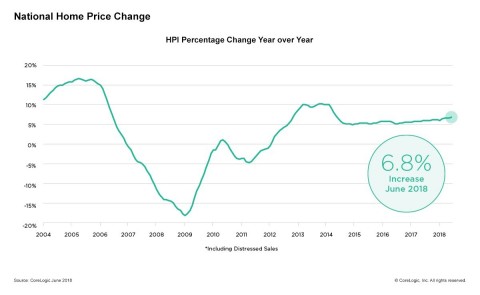- Affordability Challenges Thwart Younger Potential Buyers
- Washington, Nevada, Idaho and Utah Again Post Double-digit Annual Price Growth
- Home Prices Projected to Increase by 5.1 Percent by June 2019
IRVINE, Calif. — (BUSINESS WIRE) — August 7, 2018 — CoreLogic® (NYSE: CLGX), a leading global property information, analytics and data-enabled solutions provider, today released the CoreLogic Home Price Index (HPI™) and HPI Forecast™ for June 2018, which shows home prices rose both year over year and month over month. Home prices increased nationally by 6.8 percent year over year from June 2017 to June 2018. On a month-over-month basis, prices increased by 0.7 percent in June 2018 compared with May 2018, according to the CoreLogic HPI. (May 2018 data was revised. Revisions with public records data are standard, and to ensure accuracy, CoreLogic incorporates the newly released public data to provide updated results each month.)
This press release features multimedia. View the full release here: https://www.businesswire.com/news/home/20180807005216/en/

CoreLogic National Home Price Change; June 2018. (Graphic: Business Wire)
Looking ahead, the CoreLogic HPI Forecast indicates that the national home-price index is projected to continue to increase by 5.1 percent on a year-over-year basis from June 2018 to June 2019. On a month-over-month basis, home prices are expected to be flat from June to July 2018. The CoreLogic HPI Forecast is a projection of home prices that is calculated using the CoreLogic HPI and other economic variables. Values are derived from state-level forecasts by weighting indices according to the number of owner-occupied households for each state.
“The rise in home prices and interest rates over the past year have eroded affordability and are beginning to slow existing home sales in some markets,” said Dr. Frank Nothaft, chief economist for CoreLogic. “For June, we found in CoreLogic public records data that home sales in the San Francisco Bay Area and Southern California were down 9 and 12 percent, respectively, from one year earlier. Further increases in home prices and mortgage rates over the next year will likely dampen sales and home-price growth.”
According to the CoreLogic Market Condition Indicators (MCI), an analysis of housing values in the country’s 100 largest metropolitan areas based on housing stock, 41 percent of metropolitan areas have an overvalued housing market as of June 2018. The MCI analysis categorizes home prices in individual markets as undervalued, at value or overvalued, by comparing home prices to their long-run, sustainable levels, which are supported by local market fundamentals (such as disposable income). Additionally, as of June 2018, 24 percent of the top 100 metropolitan areas were undervalued, and 35 percent were at value. When looking at only the top 50 markets based on housing stock, 54 percent were overvalued, 14 percent were undervalued and 32 percent were at value. The MCI analysis defines an overvalued housing market as one in which home prices are at least 10 percent higher than the long-term, sustainable level. An undervalued housing market is one in which home prices are at least 10 percent below the sustainable level.
In 2018, CoreLogic together with RTi Research of Norwalk, Conn., conducted an extensive consumer housing sentiment study, combining consumer and property insights. The study assessed attitudes toward homeownership and the drivers of the home buying or renting decision process. Across the U.S., the desire to own a home is significantly higher among those in younger age cohorts. Younger millennial renters (those under the age of 29) are significantly more likely to want to buy a home in the next 12 months than older millennial or Generation X renters. However, affordability for this group is a significant issue. Sixty-three percent of younger millennials who are not interested in home ownership identified the inability to afford a home or down payment as the reason they are not interested in buying at this time. This is compared with 50 percent of older millennial renters and 52 percent of Generation X renters. For their part, boomer generation renters say their lack of interest in home ownership is driven by a lack of need at this stage in their lives.
“One-third of millennial renters reported feeling they cannot afford a down payment to buy a home,” said Frank Martell, president and CEO of CoreLogic. “With home prices rising quickly over the past few years and supplies low, first-time homebuyers face ever-growing challenges to find and buy affordable entry-level homes. More needs to be done to help our first-time buyers join the homeownership class.”
Methodology
The CoreLogic HPI™ is built on
industry-leading public record, servicing and securities real-estate
databases and incorporates more than 40 years of repeat-sales
transactions for analyzing home price trends. Generally released on the
first Tuesday of each month with an average five-week lag, the CoreLogic
HPI is designed to provide an early indication of home price trends by
market segment and for the “Single-Family Combined” tier, representing
the most comprehensive set of properties, including all sales for
single-family attached and single-family detached properties. The
indices are fully revised with each release and employ techniques to
signal turning points sooner. The CoreLogic HPI provides measures for
multiple market segments, referred to as tiers, based on property type,
price, time between sales, loan type (conforming vs. non-conforming) and
distressed sales. Broad national coverage is available from the national
level down to ZIP Code, including non-disclosure states.








